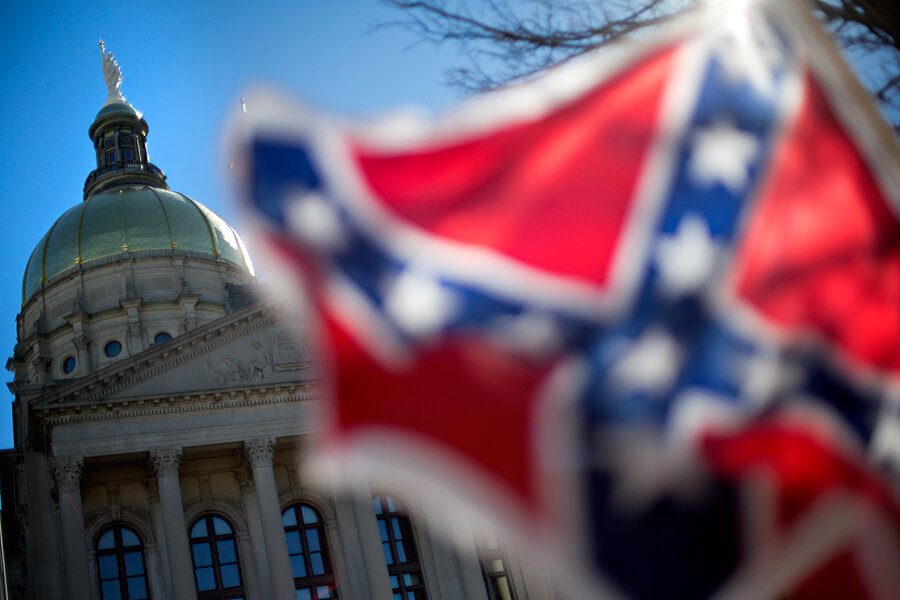Confederate flag flap at N.Y. school: why debate is hardly settled
Loading...
| Atlanta
If the Confederate flag is inarguably a hate symbol, as a Long Island Catholic school principal suggested on Wednesday, does that make Mississippi a hotbed of racial animosity, since the rebel battle flag still flies above the capitol dome in Jackson?
Brother Gary Cregan, the principal of St. Anthony’s High School in South Huntington, N.Y., defended his decision to expel two students for bringing the rebel flag to school. He said he finds it “just very hard to imagine why any student in 2014 would even consider or think that a Confederate flag would be anything other than a symbol of hate.”
But here in the South – and other, mostly rural places around the United States where the flag can still be found, often in the front yards of mobile homes – that assessment may be overconfident. Aside from still gracing the Mississippi state flag, the Southern Cross flies large along a Florida interstate, and there’s another one fluttering on the South Carolina capitol grounds.
Also, as of February, Georgians can pay $80 to get a special license plate with the rebel flag stamped on it, in honor of the Sons of Confederate Veterans, a heritage group.
To be sure, the Long Island expulsions are making news more because of the motives of the students, as well as the free-speech implications at the school. Two other students at the same school were expelled for posting blackface pictures on social media, and the principal is clearly grappling with what he has deemed troubling attitudes on his campus.
But the expulsions and Brother Gary’s comments also underscore a truism in the long-simmering cultural tensions between North and South – the idea in the North that the argument over the Confederate flag is settled and done, and the reality that in the South, any final judgment on what the flag really means, and how it should be flown, remains at a shaky stalemate.
For example, in contrast to the Long Island expulsions, the principal of Reagan High School in Winston-Salem, N.C., last year merely reprimanded a student who decided to fly the Confederate flag from the school’s flagpole. The principal called the act “in bad taste.”
The Confederate flag has long been a touchy symbol, and the boycott battles by the National Association for the Advancement of Colored People to eradicate the flag from public lands and capitol domes in the late 1990s and early 2000s came largely in response to the fact that Southern governors displayed the flag as an act of rebellion against integration in the 1950s and ’60s.
The NAACP effort was effective enough to leave Mississippi as the only state still flying the flag. In 2001, the state held a referendum on a new flag featuring a 20-star canton instead of the distinctive blue cross, but two-thirds of voters preferred the old rebel flag motif, which dates to 1894. Thirty-four percent of voters in Mississippi are black.
Part of the explanation of why the flag is far from redacted even in Southern officialdom is that many Southerners choose to overlook the reactions of the civil rights era and also reject its use by white supremacy groups, including the Ku Klux Klan.
Matthew Papay, who was forced by the University of Rochester in New York to remove a rebel flag from his dorm window last fall, agreed that the flag is “used by a small percentage of people in certain hate groups.” But he then noted, according to USA Today, that he has “never personally met a Southerner who displayed it out of hate.”
His argument for displaying the flag – that it represents a unique cultural heritage and that the school prides itself on diversity – ultimately didn’t fly with administrators, who told him he could hang it on his wall if he wanted.
But in fact, it’s in the South, often on college campuses like the University of Mississippi in Oxford, where flag debates have been the most charged. School administrators must weigh the free-speech rights of white Southerners against a sense of historical malice toward a long-suffering minority community, many of whom are direct descendants of slaves.
Just this February, someone hung a noose around the neck of a statue of James Meredith, a black student who integrated Ole Miss. A Confederate flag symbol was also left behind at the scene.
Confederate symbols “convey an image ... and that image is an image tied to the past, not a 21st-century image,” Southern historian Charles Eagles, a professor at the university, told The New York Times after the incident.
Some historians say the impulse – whether in the North or South – to redact Confederate symbols entirely from modern life smacks of historic revisionism.
Instead of on state flags, license plates, and highways, maybe the rebel flag really just belongs in a museum, where its context can best be construed, Keith Hardison, a state cultural attaché in North Carolina, told the Winston-Salem Journal last year.
In a museum setting, Mr. Hardison said, “You’re talking about ... what happened during that period; it is being properly used in its historic context. That’s the proper way to do it.”








